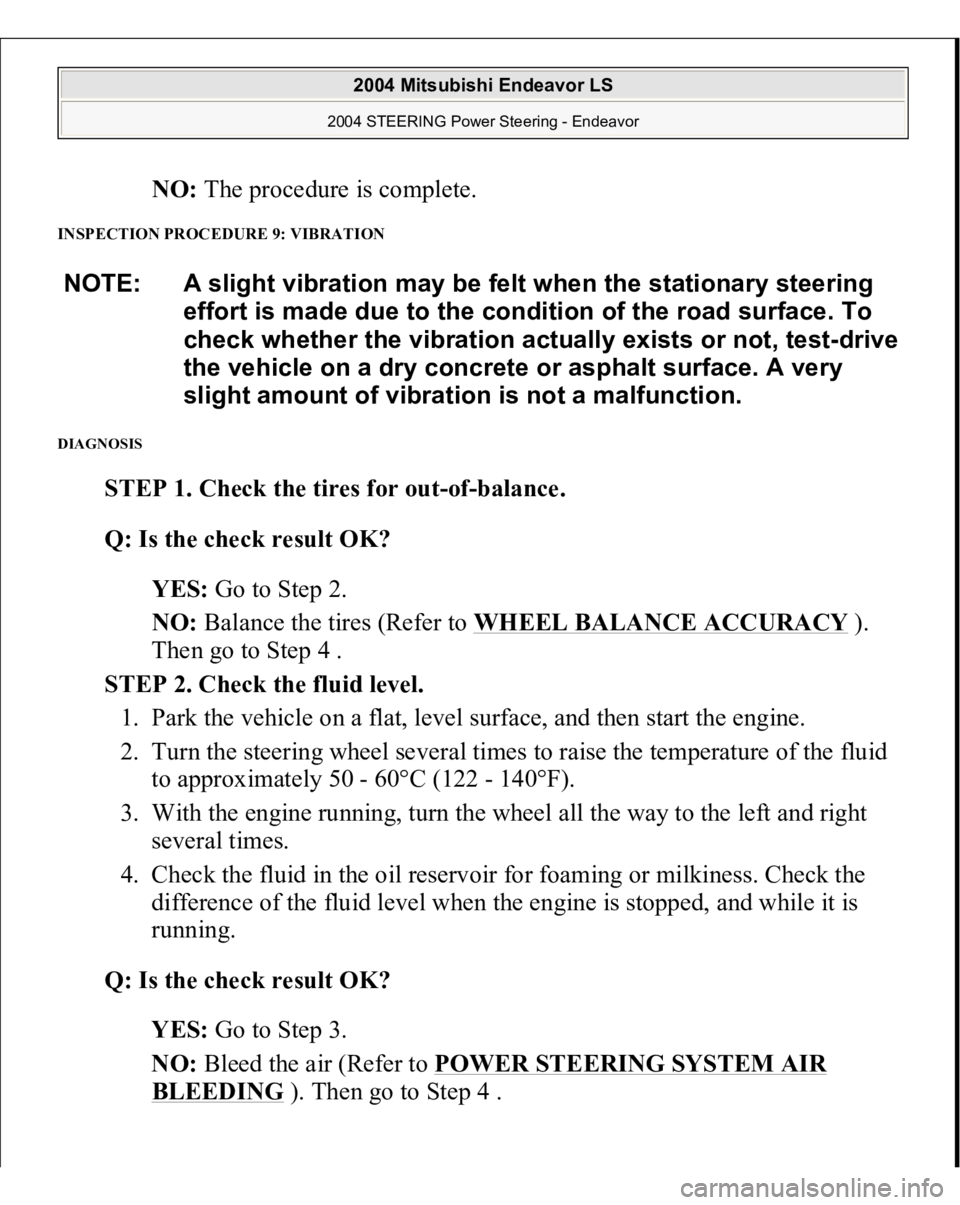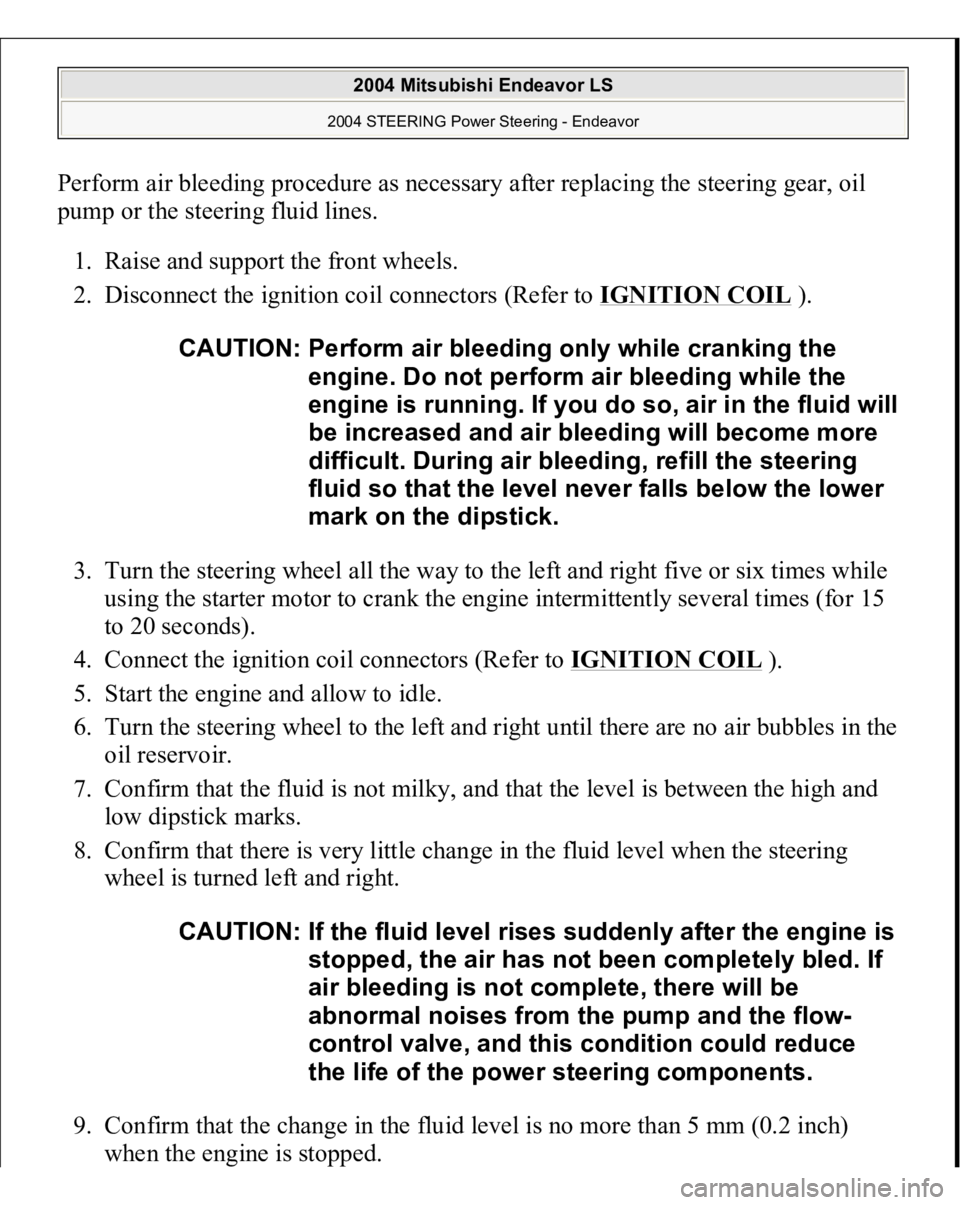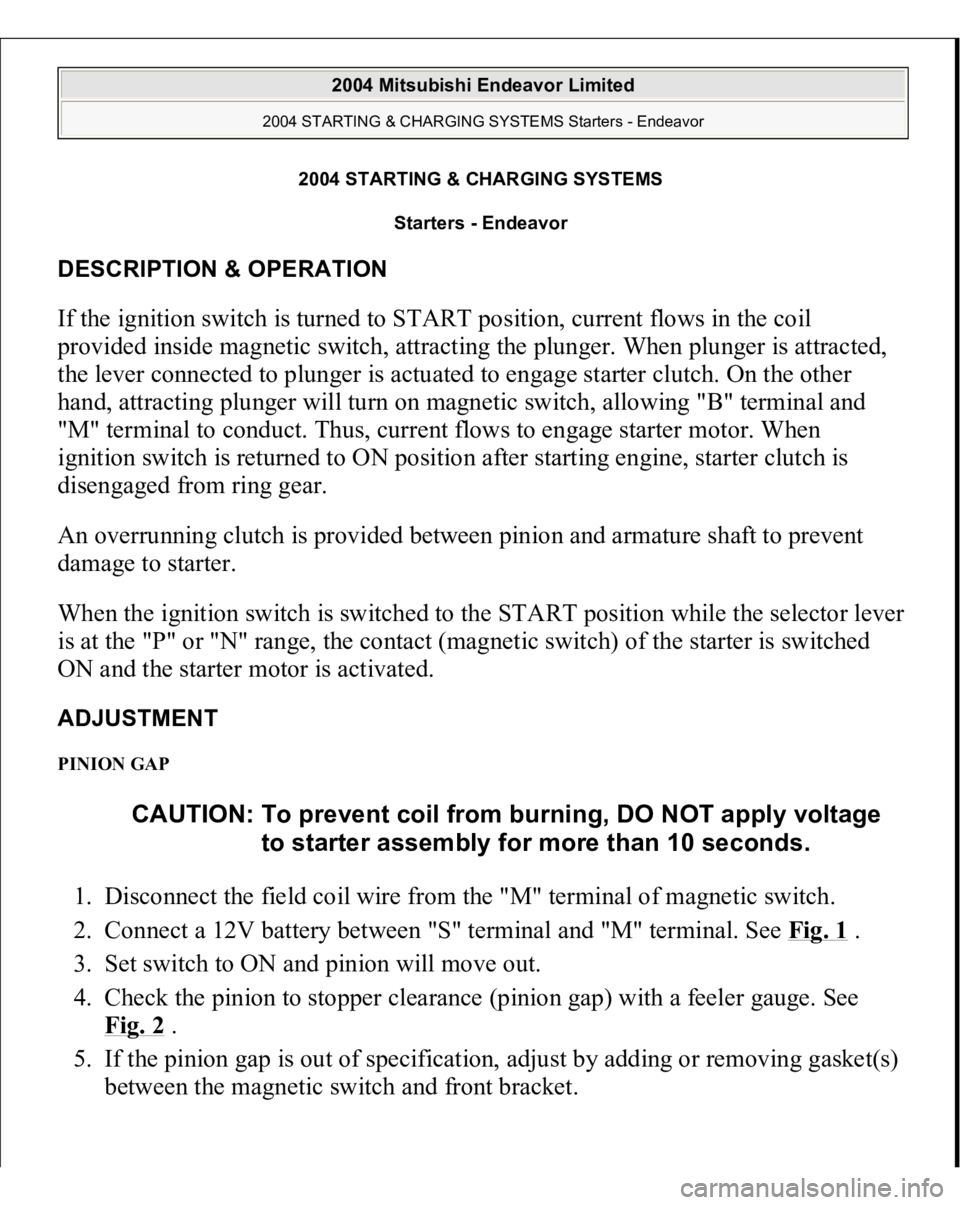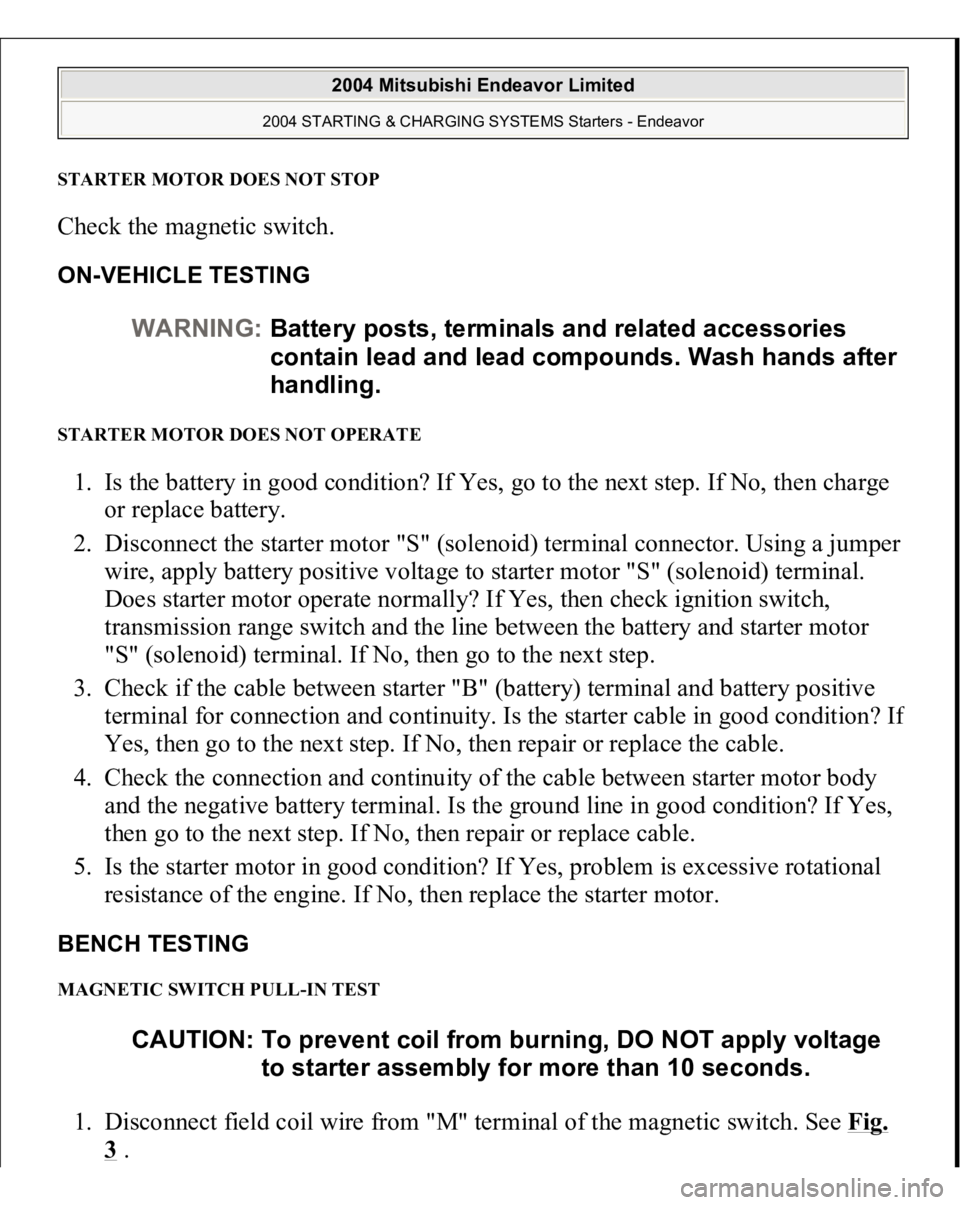Page 2827 of 3870
STEP 1. Check the fluid level.
1. Park the vehicle on a flat, level surface, and then start the engine.
2. Turn the steering wheel several times to raise the temperature of the fluid
to approximately 50 - 60°C (122 - 140°F).
3. With the engine running, turn the wheel all the way to the left and right
several times.
4. Check the fluid in the oil reservoir for foaming or milkiness. Check the
difference of the fluid level when the engine is stopped, and while it is
running.
Q: Is the check result OK?
YES: Go to Step 2.
NO: Bleed the air (Refer to POWER STEERING SYSTEM AIR
BLEEDING
). Then
go to Ste
p 4 .
2004 Mitsubishi Endeavor LS
2004 STEERING Power Steering - Endeavor
Page 2834 of 3870

NO: The procedure is complete.
INSPECTION PROCEDURE 9: VIBRATION DIAGNOSIS
STEP 1. Check the tires for out-of-balance.
Q: Is the check result OK?
YES: Go to Step 2.
NO: Balance the tires (Refer to WHEEL BALANCE ACCURACY
).
Then go to Step 4 .
STEP 2. Check the fluid level.
1. Park the vehicle on a flat, level surface, and then start the engine.
2. Turn the steering wheel several times to raise the temperature of the fluid
to approximately 50 - 60°C (122 - 140°F).
3. With the engine running, turn the wheel all the way to the left and right
several times.
4. Check the fluid in the oil reservoir for foaming or milkiness. Check the
difference of the fluid level when the engine is stopped, and while it is
running.
Q: Is the check result OK?
YES: Go to Step 3.
NO: Bleed the air (Refer to POWER STEERING SYSTEM AIR
BLEEDING
). Then go to Step 4 .
NOTE: A slight vibration may be felt when the stationary steering
effort is made due to the condition of the road surface. To
check whether the vibration actually exists or not, test-drive
the vehicle on a dry concrete or asphalt surface. A very
slight amount of vibration is not a malfunction.
2004 Mitsubishi Endeavor LS
2004 STEERING Power Steering - Endeavor
Page 2854 of 3870
1. Park the vehicle on a flat, level surface.
2. Start the engine, and then turn the steering wheel several times to raise the
temperature of the fluid to approximately 50 - 60°C (122 - 140°F).
3. With the engine running, turn the wheel all the way to the left and right several
times.
4. Check the fluid in the oil reservoir for foaming or milkiness. Check the
difference of the fluid level when the engine is stopped, and while it is running.
If the fluid contains air or has milky appearance, or the fluid level fluctuate by
5 mm (0.2 inch) or more, power steering system air bleeding should be done.
Refer to POWER STEERING SYSTEM AIR BLEEDING
.
Fig. 22: Checking Fluid Level
Courtesy of MITSUBISHI MOTOR SALES OF AMERICA.
FLUID REPLACEMENT
2004 Mitsubishi Endeavor LS
2004 STEERING Power Steering - Endeavor
Page 2856 of 3870

Perform air bleeding procedure as necessary after replacing the steering gear, oil
pump or the steering fluid lines.
1. Raise and support the front wheels.
2. Disconnect the ignition coil connectors (Refer to IGNITION COIL
).
3. Turn the steering wheel all the way to the left and right five or six times while
using the starter motor to crank the engine intermittently several times (for 15
to 20 seconds).
4. Connect the ignition coil connectors (Refer to IGNITION COIL
).
5. Start the engine and allow to idle.
6. Turn the steering wheel to the left and right until there are no air bubbles in the
oil reservoir.
7. Confirm that the fluid is not milky, and that the level is between the high and
low dipstick marks.
8. Confirm that there is very little change in the fluid level when the steering
wheel is turned left and right.
9. Confirm that the change in the fluid level is no more than 5 mm (0.2 inch)
when the en
gine is sto
pped.
CAUTION: Perform air bleeding only while cranking the
engine. Do not perform air bleeding while the
en
gine is runnin
g. If
you do so, air in the fluid will
be increased and air bleeding will become more
difficult. During air bleeding, refill the steering
fluid so that the level never falls below the lower
mark on the dipstick.
CAUTION: If the fluid level rises suddenly after the engine is
stopped, the air has not been completely bled. If
air bleeding is not complete, there will be
abnormal noises from the pump and the flow-
control valve, and this condition could reduce
the life of the power steering components.
2004 Mitsubishi Endeavor LS
2004 STEERING Power Steering - Endeavor
Page 2858 of 3870
2. Bleed air, then turn the steering wheel several times while the vehicle is not
moving so that the temperature of the fluid rises to approximately 50 - 60°C
(122 - 140°F).
3. Start the engine and idle it at 700 +/- 100 r/min.
4. Fully close the shut-off valve of the pressure gauge and measure the oil pump
relief pressure to confirm that it is within the standard value range. Open it
again immediately after checking the pressure.
Standard value: 9.3 - 9.8 MPa (1,349 - 1,421 psi)
CAUTION: The pressure gauge shut-off valve must not
remain closed for more than 10 seconds.
2004 Mitsubishi Endeavor LS
2004 STEERING Power Steering - Endeavor
Page 2861 of 3870
C (122 - 140°F).
3. The engine should be idling.
4. Disconnect the connector for the oil pressure switch, and place an ohmmeter at
the switch.
5. Gradually close the shut-off valve of the pressure gauge and increase the
hydraulic pressure, then check whether or not the hydraulic pressure that
activates the switch is the standard value.
Standard value: 18 - 2.4 MPa (261 - 348 psi)
6. Gradually open the shut-off valve and reduce the hydraulic pressure; then
check whether or not the hydraulic pressure that deactivates the switch is the
standard value.
Standard value: 0.8 - 2.4 MPa (116 - 348 psi)
7. Remove the special tools MB991548, MB990662 and MB991549, and then
tighten the pressure tube flare nut to the specified torque.
Tightening torque: 15 +/- 3 N.m (11 +/- 2 ft-lb)
8. Bleed the system. (Refer to POWER STEERING SYSTEM AIR BLEEDING
).
2004 Mitsubishi Endeavor LS
2004 STEERING Power Steering - Endeavor
Page 3534 of 3870

2004 STARTING & CHARGING SYSTEMS
Starters - Endeavor
DESCRIPTION & OPERATION If the ignition switch is turned to START position, current flows in the coil
provided inside magnetic switch, attracting the plunger. When plunger is attracted,
the lever connected to plunger is actuated to engage starter clutch. On the other
hand, attracting plunger will turn on magnetic switch, allowing "B" terminal and
"M" terminal to conduct. Thus, current flows to engage starter motor. When
ignition switch is returned to ON position after starting engine, starter clutch is
disengaged from ring gear.
An overrunning clutch is provided between pinion and armature shaft to prevent
damage to starter.
When the ignition switch is switched to the START position while the selector leve
r
is at the "P" or "N" range, the contact (magnetic switch) of the starter is switched
ON and the starter motor is activated.
ADJUSTMENT PINION GAP 1. Disconnect the field coil wire from the "M" terminal of magnetic switch.
2. Connect a 12V battery between "S" terminal and "M" terminal. See Fig. 1
.
3. Set switch to ON and pinion will move out.
4. Check the pinion to stopper clearance (pinion gap) with a feeler gauge. See
Fig. 2
.
5. If the pinion gap is out of specification, adjust by adding or removing gasket(s)
between the ma
gnetic switch and front bracket. CAUTION: To prevent coil from burning, DO NOT apply voltage
to starter assembly for more than 10 seconds.
2004 Mitsubishi Endeavor Limited
2004 STARTING & CHARGING SYSTEMS Starters - Endeavor
2004 Mitsubishi Endeavor Limited
2004 STARTING & CHARGING SYSTEMS Starters - Endeavor
Page 3537 of 3870

STARTER MOTOR DOES NOT STOPCheck the magnetic switch. ON-VEHICLE TESTING STARTER MOTOR DOES NOT OPERATE 1. Is the battery in good condition? If Yes, go to the next step. If No, then charge
or replace battery.
2. Disconnect the starter motor "S" (solenoid) terminal connector. Using a jumper
wire, apply battery positive voltage to starter motor "S" (solenoid) terminal.
Does starter motor operate normally? If Yes, then check ignition switch,
transmission range switch and the line between the battery and starter motor
"S" (solenoid) terminal. If No, then go to the next step.
3. Check if the cable between starter "B" (battery) terminal and battery positive
terminal for connection and continuity. Is the starter cable in good condition? I
f
Yes, then go to the next step. If No, then repair or replace the cable.
4. Check the connection and continuity of the cable between starter motor body
and the negative battery terminal. Is the ground line in good condition? If Yes,
then go to the next step. If No, then repair or replace cable.
5. Is the starter motor in good condition? If Yes, problem is excessive rotational
resistance of the engine. If No, then replace the starter motor.
BENCH TESTING MAGNETIC SWITCH PULL-IN TEST 1. Disconnect field coil wire from "M" terminal of the magnetic switch. See Fig.
3 . WARNING:Battery posts, terminals and related accessories
contain lead and lead compounds. Wash hands after
handling.
CAUTION: To prevent coil from burning, DO NOT apply voltage
to starter assembly for more than 10 seconds.
2004 Mitsubishi Endeavor Limited
2004 STARTING & CHARGING SYSTEMS Starters - Endeavor